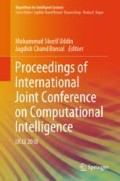Abstract
In this paper, we present a machine learning approach to detect diabetic retinopathy from retinal images which is one of the most common diseases among diabetic patient. In our experiment, Inception v3 is used as the machine learning approach. Inception is a convolutional neural network classifier by Google. The dataset is collected from Kaggle which contains images of five categories. We used a pretrained model of the classifier which is trained on 1000 classes. We proposed three characterizations of the problem. Our classifier worked better on the first two characterizations than the third one.
Access this chapter
Tax calculation will be finalised at checkout
Purchases are for personal use only
References
Alban M, Gilligan T (2016) Automated detection of diabetic retinopathy using fluorescein angiography photographs. Report of standford education
Bhatkar A, Kharat GU (2015) Detection of diabetic retinopathy in retinal images using mlp classifier. In: Proceedings of 2015 IEEE international symposium on nanoelectronic and information systems, pp 331–335. https://doi.org/10.1109/iNIS.2015.30
Diabetic retinopathy. https://www.mayoclinic.org/diseases-conditions/diabetic-retinopathy/symptoms-causes/syc-20371611
Diabetic retinopathy detection. https://www.kaggle.com/c/diabetic-retinopathy-detection
ElTanboly AH, Palacio A, Shalaby AM, Switala AE, Helmy O, Schaal S, El-Baz A (2018) An automated approach for early detection of diabetic retinopathy using sd-oct images. Front Biosci (Elit Ed) 10:197–207. https://doi.org/10.2741/e817
Facts about diabetic eye disease. https://nei.nih.gov/health/diabetic/retinopathy
Inception modules: explained and implemented. https://hacktilldawn.com/2016/09/25/inception-modules-explained-and-implemented
Nivetha CV, Sumathi S, Chandrasekaran M (2017) Retinal blood vessels extraction and detection of exudates using wavelet transform and pnn approach for the assessment of diabetic retinopathy. In: Proceedings of 2017 international conference on communication and signal processing (ICCSP), pp 1962–1966. https://doi.org/10.1109/ICCSP.2017.8286743
Pratt H, Coenen F, Broadbent DM, Harding SP, Zheng Y (2016) Convolutional neural networks for diabetic retinopathy. Procedia Comput Sci 90:200–205. https://doi.org/10.1016/j.procs.2016.07.014
Rajalakshmi R, Subashini R, Anjana RM, Mohan V (2018) Automated diabetic retinopathy detection in smartphone-based fundus photography using artificial intelligence. Eye 32:1138–1144. https://doi.org/10.1038/s41433-018-0064-9
Szegedy C, Vanhoucke V, Ioffe S, Shlens J, Wojna Z (2016) Rethinking the inception architecture for computer vision. In: Proceedings of 2016 IEEE conference on computer vision and pattern recognition (CVPR), pp 2818–2826. https://doi.org/10.1109/CVPR.2016.308
Tapp RJ, Shaw J, Harper C, de Courten MPJ, Balkau B, Mccarty DJ, Taylor HR, Welborn TA, Zimmet PZ (2003) The prevalence of and factors associated with diabetic retinopathy in the australian population. Diabetes care 26(6):1731–7. https://doi.org/10.2337/diacare.26.6.1731
Wang Z, Yin Y, Shi J, Fang W, Li H, Wang X (2017) Zoom-in-net: deep mining lesions for diabetic retinopathy detection. In: International conference on medical image computing and computer-assisted intervention. Springer, Berlin, pp 267–275. https://doi.org/10.1007/978-3-319-66179-7_31
Zohora SE, Chakraborty S, Khan AM, Dey N (2016) Detection of exudates in diabetic retinopathy: a review. In: proceedings of 2016 international conference on electrical, electronics, and optimization techniques (ICEEOT), pp 2063–2068. https://doi.org/10.1109/ICEEOT.2016.7755052
Author information
Authors and Affiliations
Corresponding author
Editor information
Editors and Affiliations
Rights and permissions
Copyright information
© 2020 Springer Nature Singapore Pte Ltd.
About this paper
Cite this paper
Chowdhury, M.M.H., Meem, N.T.A., Marium-E-Jannat (2020). A Machine Learning Approach to Detect Diabetic Retinopathy Using Convolutional Neural Network. In: Uddin, M., Bansal, J. (eds) Proceedings of International Joint Conference on Computational Intelligence. Algorithms for Intelligent Systems. Springer, Singapore. https://doi.org/10.1007/978-981-13-7564-4_23
Download citation
DOI: https://doi.org/10.1007/978-981-13-7564-4_23
Published:
Publisher Name: Springer, Singapore
Print ISBN: 978-981-13-7563-7
Online ISBN: 978-981-13-7564-4
eBook Packages: Intelligent Technologies and RoboticsIntelligent Technologies and Robotics (R0)

